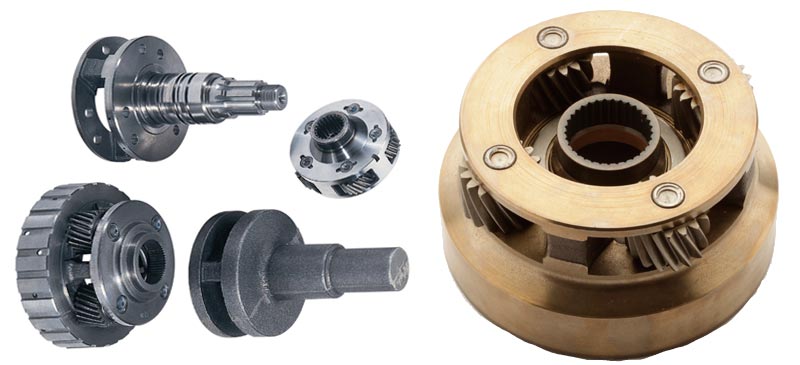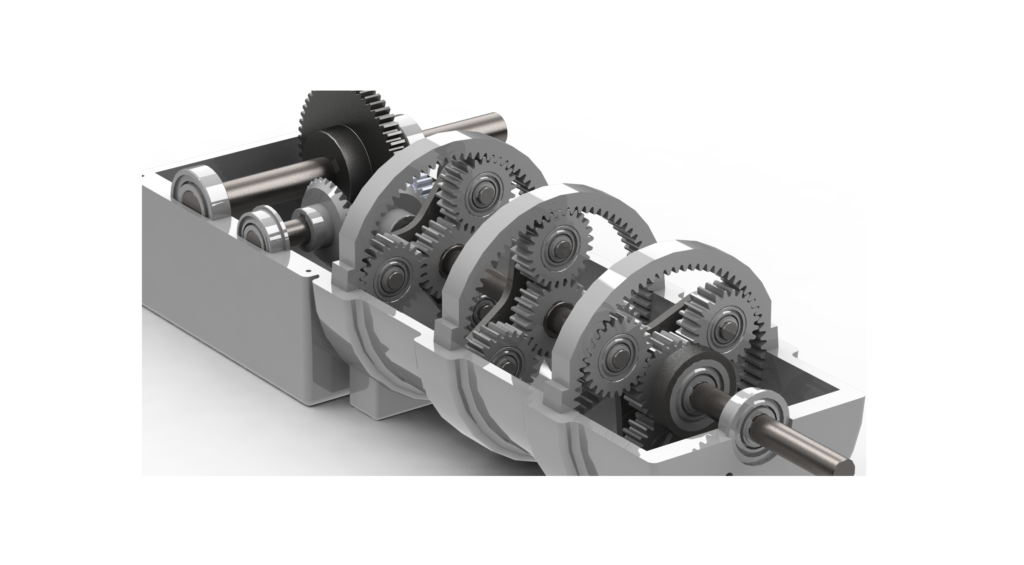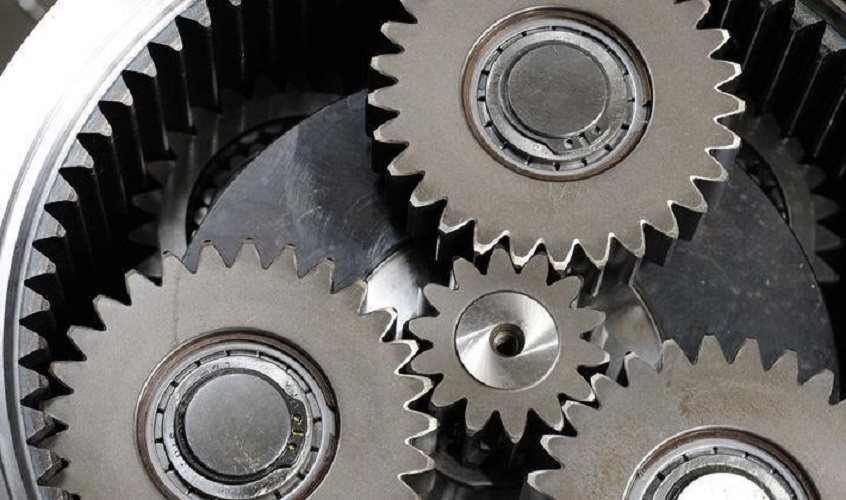Product Description
Product Parameters
Precision planetary reducer corner hole output gear reducer
PLANETX planetary reduce
Planetary reducer is widely used in industrial products due to its small size, light weight, large torque, wide speed ratio range, high rigidity, high precision, high transmission efficiency, maintenance free and other characteristics.
The planetary reducer structure is composed of a sun gear and a planet gear to form an external mesh, and a planet gear and an internal gear ring to form an internal mesh, so that the planet gear can realize revolution while realizing self rotation and maximum transmission of guarantee force; The minimum speed ratio of single-stage reduction is 3, and the maximum speed ratio is generally not more than 10. Common reduction ratios are 3, 4, 5, 6, 7, 8, and 10. The number of reducer stages is generally not more than 3, and the speed ratio is not more than 1.
Most planetary reducers are used with servo motors to reduce speed, increase torque, increase inertia, and ensure return accuracy (the higher the return accuracy, the higher the price). The maximum rated input speed of planetary reducers can reach 12000 rpm (depending on the size of the reducer itself, the larger the reducer, the smaller the rated input speed), and the operating temperature is generally between – 40 ºC and 120 ºC.
| Model | Unit | PZE060A PZF060A PZK060A |
PZE085A PZF085A PZK085A |
PZE115A PZF115A PZK115A |
PZE140A PZF140A PZF160A PZK140A PZK160A |
Ratios(i) | Stages |
|
Rated output torque Nm |
16.5 | 63.0 | 155.0 | 310.0 | 3 | 1-stages | |
| 26.0 | 90.0 | 230.0 | 460.0 | 4 | |||
| 28.0 | 100.0 | 245.0 | 500.0 | 5 | |||
| 20.0 | 68.0 | 165.0 | 340.0 | 7 | |||
| 12.5 | 43.0 | 95.0 | 195.0 | 10 | |||
| 19.5 | 75.0 | 185.0 | 370.0 | 9 |
2-stages |
||
| 31.5 | 110.0 | 275.0 | 550.0 | 12 | |||
| 31.5 | 110.0 | 275.0 | 550.0 | 16 | |||
| 31.5 | 110.0 | 275.0 | 550.0 | 20 | |||
| 33.5 | 120.0 | 290.0 | 600.0 | 25 | |||
| 31.5 | 110.0 | 275.0 | 550.0 | 28 | |||
| 33.5 | 120.0 | 290.0 | 600.0 | 35 | |||
| 31.5 | 110.0 | 275.0 | 550.0 | 40 | |||
| 33.5 | 120.0 | 290.0 | 600.0 | 50 | |||
| 24.0 | 81.0 | 195.0 | 400.0 | 70 | |||
| 37.5 | 130.0 | 335.0 | 665.0 | 80 | |||
| 37.5 | 130.0 | 335.0 | 665.0 | 100 |
3-stages |
||
| 40.0 | 145.0 | 355.0 | 720.0 | 125 | |||
| 37.5 | 130.0 | 335.0 | 665.0 | 140 | |||
| 40.0 | 145.0 | 355.0 | 720.0 | 175 | |||
| 37.5 | 130.0 | 335.0 | 665.0 | 200 | |||
| 40.0 | 145.0 | 355.0 | 720.0 | 250 | |||
| 37.5 | 130.0 | 335.0 | 665.0 | 280 | |||
| 40.0 | 145.0 | 355.0 | 720.0 | 350 | |||
| 37.5 | 130.0 | 335.0 | 665.0 | 400 | |||
| 40.0 | 145.0 | 355.0 | 720.0 | 500 | |||
| 28.0 | 95.0 | 230.0 | 480.0 | 700 | |||
| 18.8 | 62.0 | 135.0 | 280.0 | 1000 | |||
| Max.output torque |
Nm | 2/2*Nominal torqute | |||||
We strive for meticulousness in every process,and strive for perfection in every detail. The production management system, inspection and test system,quality control system,etc. are integrated into the production process of aif products, and
advanced technology, production and inspection equipment are widely used to truly serve customers at home and abroad with high quality and high standards!
Lifetime:20000h
Minimum operating temperature:-25ºC
Maximum operating temperature:+90ºC
Degree of protection:IP65
Lubrication method:Long term lubrication
Installation method:Any
Direction of rotation: Output, input in the same direction
Full load efficiency:1-stages 90%/2-stages 88% /3-stages 84
Q: How to get a quick quote
A: Please provide the following information when contacting us
- Motor brand
- Motor model
- Motor dimension drawing
- What is the gear ratio
Q: How long is your delivery date
A: We all install it now, but it takes 3-5 days if it is not non-standard. Non standard 10-15 days, depending on the specific situation
Q:Do you provide samples, free or extra
A: You can reserve 1 for purchase on demand
| Warranty: | 1 Year |
|---|---|
| Classification: | Gear Parts |
| Processing Type: | Metal Processing |
| Match Machine: | Weaving Equipment |
| Material: | Metal |
| Processing Level: | Precision Finishing |
| Customization: |
Available
| Customized Request |
|---|

How do you calculate the gear ratio involving sun, planet, and ring gears?
The gear ratio in a planetary gear system can be calculated by considering the number of teeth on the sun gear, planet gears, and ring gear. The gear ratio determines the relationship between the input speed and the output speed of the system. Here’s how you can calculate the gear ratio:
- Step 1: Count the Teeth:
Count the number of teeth on the sun gear (S), the planet gears (P), and the ring gear (R). These numbers represent the respective gear’s tooth count.
- Step 2: Determine the Gear Arrangement:
Identify the gear arrangement. In a simple planetary gear system, the sun gear is at the center, surrounded by planet gears, and enclosed by the ring gear.
- Step 3: Calculate the Gear Ratio:
The gear ratio (GR) can be determined using the formula:
GR = (R + P) / S
Where:
- R represents the number of teeth on the ring gear
- P represents the number of teeth on the planet gears (assuming they have the same number of teeth)
- S represents the number of teeth on the sun gear
The resulting gear ratio represents the speed relationship between the input and output of the planetary gear system. A gear ratio greater than 1 indicates a speed reduction, while a gear ratio less than 1 indicates a speed increase.
It’s important to note that in more complex planetary gear systems, where there are multiple sets of planet gears or additional gears, the calculation of the gear ratio may involve considering multiple gear stages and their respective tooth counts.
In summary, to calculate the gear ratio involving sun, planet, and ring gears, you need to count the teeth on each gear and use the formula (R + P) / S, where R is the number of teeth on the ring gear, P is the number of teeth on the planet gears, and S is the number of teeth on the sun gear. This calculation provides the gear ratio that defines the speed relationship between the input and output of the planetary gear system.

Can you explain the process of gear shifting in planetary gear systems?
Gear shifting in planetary gear systems involves changing the gear ratio by engaging or disengaging specific components of the gear set. Let’s explore the process of gear shifting in more detail:
- Clutching and Braking:
The gear shifting process in planetary gear systems primarily relies on clutching and braking mechanisms. These mechanisms selectively connect or disconnect various gears within the system to achieve the desired gear ratio. Here are the key steps involved:
- Clutch Engagement:
To shift to a higher gear ratio, the clutch associated with the gear component that needs to be engaged is activated. The clutch connects the rotating member, such as the sun gear, planet carrier, or ring gear, to the stationary member, allowing torque transmission. This engagement results in a change in the gear ratio, leading to higher speed or torque output depending on the specific gear set configuration.
- Brake Application:
On the other hand, to shift to a lower gear ratio, a brake associated with the gear component that needs to be disengaged is applied. The brake immobilizes or slows down the rotation of the selected gear element, preventing it from transmitting torque. By selectively braking certain components, the gear ratio is altered, resulting in a lower speed or higher torque output.
- Sequential Shifting:
In some planetary gear systems, gear shifting is performed sequentially. This means that one gear component is engaged or disengaged at a time, gradually transitioning from one gear ratio to another. Sequential shifting allows for smooth and controlled gear changes, minimizing the stress on the transmission components and ensuring seamless power transmission.
- Electronic Control:
In modern applications, gear shifting in planetary gear systems is often electronically controlled. Electronic control systems utilize sensors, actuators, and a control unit to monitor various parameters such as vehicle speed, engine load, and driver input. Based on these inputs, the control unit determines the optimal gear shift points and actuates the clutches and brakes accordingly. Electronic control enhances the efficiency, precision, and automation of the gear shifting process.
In summary, gear shifting in planetary gear systems involves the engagement and disengagement of clutches and brakes to alter the gear ratio. By selectively connecting or disconnecting specific gear components, the speed and torque output can be adjusted. Sequential shifting and electronic control systems further enhance the gear shifting process, providing smooth and efficient operation in various applications, including automotive transmissions and industrial machinery.

Can you describe the role of sun gears, planet gears, and ring gears in planetary systems?
In a planetary gear system, each component—the sun gear, planet gears, and ring gear—plays a crucial role in the overall operation and functionality. Let’s explore the roles of these gears:
- Sun Gear:
The sun gear is a central component in a planetary gear system. It is typically located at the center and is driven by an input source such as a motor or engine. The sun gear receives the input power and transmits it to the other gears in the system. As the sun gear rotates, it drives the rotation of the planet gears, which, in turn, contribute to the overall gear operation. The size and number of teeth on the sun gear determine the gear ratio and torque characteristics of the system.
- Planet Gears:
The planet gears are gears that surround the sun gear in a planetary gear system. They are typically smaller in size compared to the sun gear and are connected to a carrier or arm. The planet gears mesh with both the sun gear and the ring gear. As the sun gear rotates, it drives the rotation of the planet gears. The planet gears exhibit both rotational and orbital motion. While they rotate on their own axes, they also orbit around the sun gear. This combination of rotational and orbital movement allows the planet gears to transmit torque and contribute to the overall gear reduction or amplification. The arrangement and number of planet gears can vary depending on the specific design and requirements of the system.
- Ring Gear:
The ring gear is the outermost gear in a planetary gear system. It has internal teeth that mesh with the planet gears. The ring gear remains fixed or stationary while the sun gear and planet gears rotate. The interaction between the planet gears and the ring gear enables the gear system to achieve gear reduction or amplification. The size and number of teeth on the ring gear also influence the gear ratio and torque characteristics of the system.
In summary, the sun gear serves as the primary driver, receiving the input power and transmitting it to the other gears. The planet gears rotate and orbit around the sun gear, contributing to torque transmission and gear functionality. The ring gear remains fixed and meshes with the planet gears, allowing for gear reduction or amplification. Together, these gears work in harmony to achieve the desired gear ratios, torque transmission, and overall operation of planetary gear systems.


editor by CX 2023-10-12